It's going to be awesome.
I read the wikipedia entry on RPGs and made random notes. Some we can probably make use of.

@HiddenX: I thought about it some and now think that we don't really need to mention "western" or "japanese" in the introduction, i.e. you can remove that sentence. If the must-have's are fulfilled, a CRPG it is. Instead, I would add "W-RPG" as a tag to make it possible to distinguish it from "J-RPGs".
Random notes
- replayability (randomized levels, items, …)
- can do things you can't in real life (setting = fantasy or sci-fi)
- automapping?
- minigames?
tags:
- roguelike: players complete quests by exploring randomly generated dungeons
- additional genre: Shooter (includes "Action"), examples: Deus Ex, Mass Effect, STALKER
- Tactical aka "simulation RPG" in Japan; examples: Fire Emblem, XCOM
char development:
- magic in some form is in the game, in addition to skills and weapons
- abilities can unlock others or branch
- character classes can be changed during the game
exploration:
- allow players to return to previously visited location
- Players must acquire enough power to overcome a major challenge in order to progress to the next area
- Players can trade items for currency and better equipment
- Trade takes place while interacting with certain friendly non-player characters
- inventory exists
- inventory size is limited
- immersion: types of enemies make sense in the area they are encountered in
- immersion: enemies are wandering persistently (no random encounters)
- day/night cycles and effects
story:
- player typically must complete a linear sequence of certain quests in order to reach the end of the game's story
- moral choices & consequences (good/evil)?
- dramatic, character-driven storyline dealing with serious themes and subject matter
- intricately related characters who had distinctive personalities and traits; players assuming the roles of people who cared about each other, fell in love or even had families; romance
- themes, symbols, and characters taken from religions or myth
- character development within the narrative
- NPCs serve more than one purpose
- player's main character is defined
combat:
- battles viewed from multiple different angles rather than a single angle



 )
)